MONDAY
MAY 16 - 2016
Brook
Meadow
I had a walk
through the meadow this morning, which will be the
last one for a week, as we are off to the Isle of
Wight for a short break. I had a look for Ragged
Robin again on the Lumley area, but could only
find the same two flowering plants that I saw
yesterday. I did note a good flowering of Common
Mouse-ear and Common Sorrel in the same
area.
Marsh Foxtail is now in flower, slightly
earlier than usual, in the regular spot in the wet
area around the Lumley puddle. This looks very much
like a smaller version of the very tall Meadow Foxtail
which is currently widespread around the meadow.
There are now many
flowering plants of Celery-leaved Buttercup on
the east side of the south meadow. The plants are all
along what we used to call the Bramble path, though
most of the Bramble has been removed during the flood
defence work. This is the best show of Celery-leaved
Buttercup I have ever seen anywhere; there must be a
good 100 quite substantial plants. As Celery-leaved
Buttercup is an annual, I suspect these plants will
have originated from seeds brought in inadvertently
during the flood defence work on the bund around the
garden of Gooseberry Cottage.
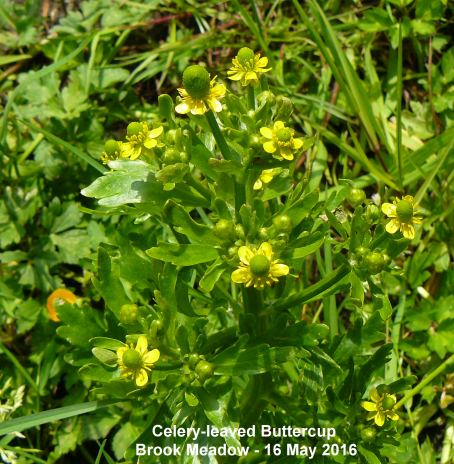
While I was admiring
the Celery-leaved Buttercup, my first Speckled
Wood of the year few past and landed conveniently
for me to take its photo. Thanks.
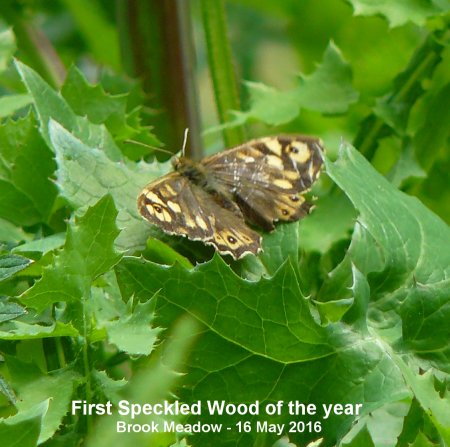
Slipper
Millpond
I carried on
to Slipper Millpond to check on the Great
Black-backed Gull nest, as this was my predicted
hatching date. However, there was no change; the
female was still sitting tight on the nest with no
sign of any activity beneath her while her mate waited
patiently beside her.
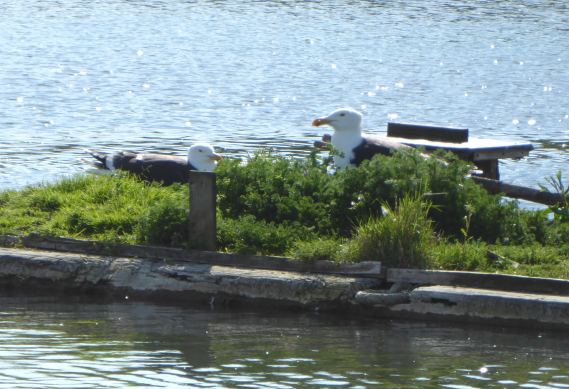
The Mute Swan
family was not on the pond, but were on the low
water Dolphin Lake which runs adjacent to Slipper
Millpond. This is a popular spot for swans as it is
the outlet for fresh water from the River Ems and
probably contains plenty of nutritious food. The
cygnets are also safer than on the pond itself where
the Great Black-backed Gulls will soon be on the look
out for tasty morsels to feed their young. My guess is
that the adult swans took their brood over the sluice
gates at high water and into the harbour from where
access to Dolphin Lake is easy.
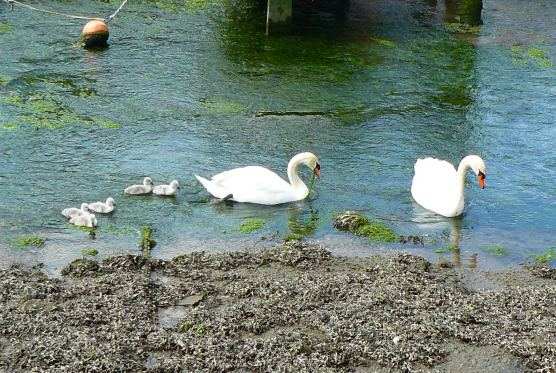
Peter
Pond
Mike Wells
spent about an hour hoping to photograph one of the
recently sighted Water Voles from the small bridge
north of Peter Pond, but no luck. He walked past
Gooseberry Cottage to the reed beds, attempting to
photograph one of the very vocal Reed Warblers.
Eventually one flew across the gravel path and perched
in a blossoming shrub.
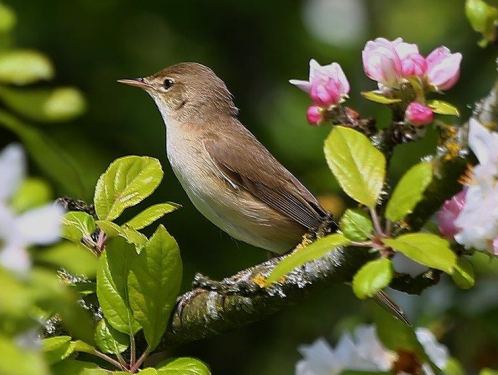
Chichester
Peregrines
Neal Scott was
also watching the Peregrines at Chichester Cathedral
on Saturday morning when the female caught a pigeon.
Neal got some great action photos of a Peregrine in
flight - the best I have seen. Well done Neal.
Don't forget to check
the live nest cam on the web site at . . .
http://www.chichesterperegrines.co.uk/live%20link.htm
SUNDAY
MAY 15 - 2016
Brook
Meadow
I went over to
the meadow this morning to update the displays in the
three main signcases with conservation and wildlife
news and photos. While I was there I discovered the
first Ragged Robin flowers of the year, living
up to their name, very ragged!

They are a bit later
than the last two years, though the first dates do
vary quite a bit from one year to the next. I counted
just two plants in flower. The annual counts have been
very poor for the past 4 years; only 34 were recorded
last year, while 1012 and 2013 had only 20 and 12
plants respectively. This was in sharp contrast to a
bumper year of 625 in 2010. See web site link for
details of past Ragged Robin counts on Brook Meadow .
. . http://www.brook-meadow.hampshire.org.uk/bm-plant-counts.html
A fly with attractive
veined wings and distinctive grey stripes on its
thorax landed on a signcase. From my perusal of
Chinery's book I think it could be a Snipe Fly
possibly Atherix ibis - though I shall
soon be corrected. I also had a black fly for company
which was not at all disturbed when I worked on the
signcase. This looks like a St Mark's Fly which
usually appears close to St Mark's Day on April 25th.
I did not see any swarms this year, maybe it was too
cold for them?
Langstone
Mill Pond
Peter
Milinets-Raby Popped down to Langstone Mill Pond late
morning (11:48am to 12:40pm - low tide). Not a great
deal happening.
Langstone Mill Pond: 2 male and a female Gadwall, 4
Reed Warblers holding territory (2 seen singing), 7
Swallows over along with 2 Swift, Goldcrest singing
and Little Egrets very quiet, not a single gobble
sound out of the colony, all birds sitting tight on
nests, partners obviously out feeding somewhere. A
female Mallard with 3 tiny ducklings (3 days old -
seen Friday).
Off shore: 2 Shelduck, 2 Great Crested Grebe in the
channel and over 23+ Med Gulls over heading to the
harbour, having flown in from the north.
Big
Day Bird List
Yesterday: John Norton and Peter went out for a Big
Day List keeping to the east of the county of
Hampshire.
"We started at dawn at Whitehill (north section of
Woolmer) for Woodcock, Nightjar, Tawny Owl, Garden
Warbler and Firecrest. Woolmer Pond for Greylag Goose,
Hobby, Cuckoo, Pochard, Bullfinch and Sand Martin.
Heath Pond, Petersfield for 7 Egyptian Geese. Buriton
Pond for Nuthatch. Holt Down for Raven. Chalton Down
for Turtle Dove and Yellowhammer. Langstone Mill Pond
for Little Egret, Gadwall and Tufted Duck. Pigeon
House Lane for 13 male and 1 female Mandarin Duck and
Red-legged Partridge. Farlington Marshes for Lesser
Whitethroat, Lapwing, Cetti's Warbler, Med Gull,
Whimbrel and Bearded Tit. Luckily bumped into a Red
Kite near Hundred Acres. Titchfield Haven for
Garganey, Sanderling, Grey Plover, Dunlin, Avocet,
Greenshank, Black-tailed Godwit and Stonechat. Kites
Croft for Peregrine. We finished at 3:30pm with a
grand total of 103. We missed loads of species, some
embarrassingly so i.e. Skylark, Redstart, Nightingale,
Shoveler and Common Sandpiper. Let's hope we have
better luck next time - Jan the First!
Adders
Yesterday, Ken
and Romney Turner got a good sighting of two male
Adders courting a brownish looking female. She says,
"One of the males was quite black coloured and the
other much more white in the pattern. The darker one
was more dominant and eventually saw off the lighter
one which went into a sunny patch to sulk. The female
was quite a lot fatter than the males and completely
different colour as you can see from the photo which
show male and female courting."
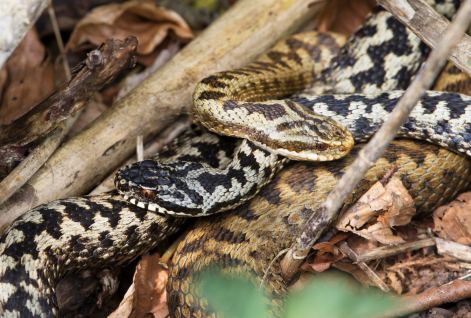
Hornet
Joyce Sawyer
had a Hornet in her garden yesterday. It landed in a
pool, but she (brave lady) rescued it and, after it
had dried out, it flew away. Well, done, Joyce!
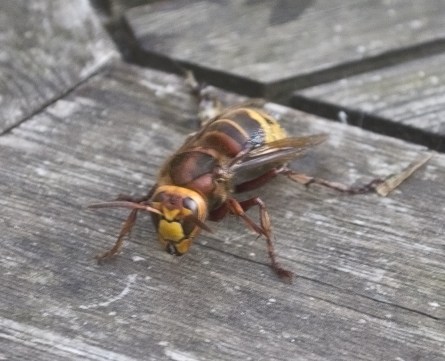
Bats
in Emsworth
Brendan
Gibb-Gray witnessed an aerial display by at least two
Bats between 6 and 7 Chequers Quay. Brendan says it is
the first time he have seen this for some years and
would like to know which species they are and where
they roost. Could it be the old antique centre?
Message passed on to Nik Knight.
Baffins
News
Eric Eddles
had another pleasant surprise this afternoon when a
Canada goose family appeared on Baffins Pond. Eric
says the swan family is doing well also.
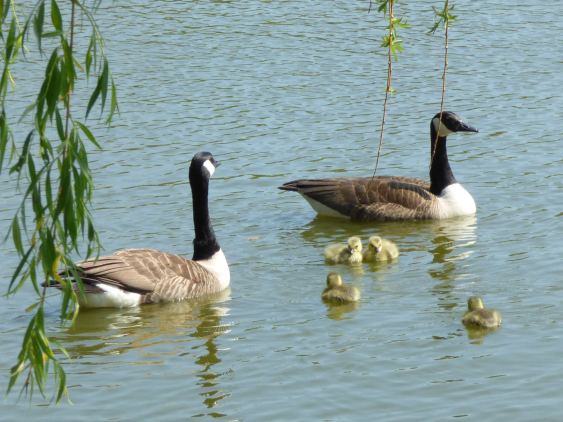
SATURDAY
MAY 14 - 2016
Chichester
Peregrines
This morning
Jean and I had coffee in the cafe behind Chichester
Cathedral where the Royal Society for the Protection
of Birds had their usual Peregrine watching booth with
telescopes and a live nest camera.
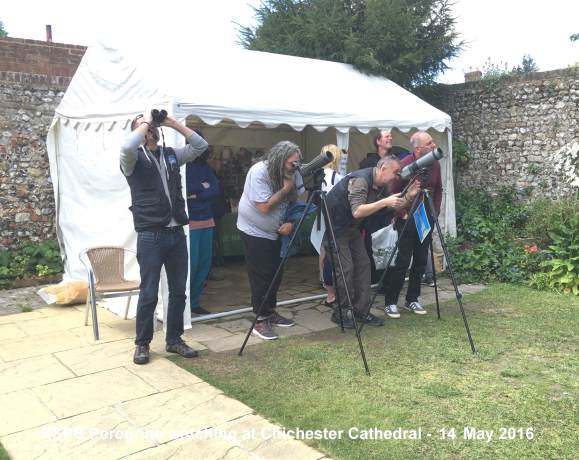
One of the volunteers
told me there were four chicks hatched 2½ weeks
ago. Unusually, all four chicks hatched together;
apparently they normally hatch at 24 hour intervals.
They will be sexed and ringed by Graham Roberts in a
few days time. Here is a photo of the chicks on
monitor.
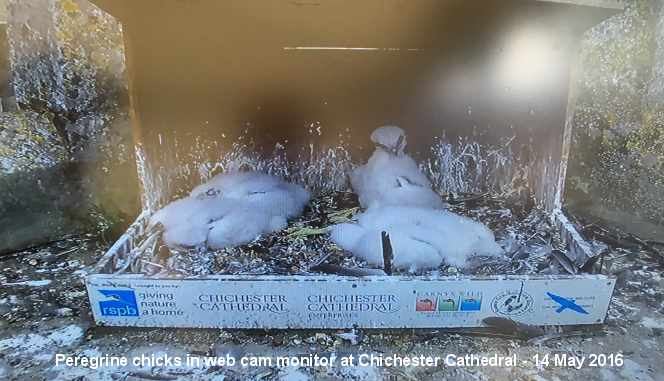
You can view the live
web cam on the nest on the link at . . .
http://www.chichesterperegrines.co.uk/live%20link.htm
While I was there one
of the birds (thought to be the female) came in with a
freshly caught prey (thought to be a Feral Pigeon) and
proceeded to pluck it in full view of the telescopes
trained on it. Here is a digiscoped shot I got with my
camera through the telescope lens - not too bad I
thought. I will have to try this method more often!
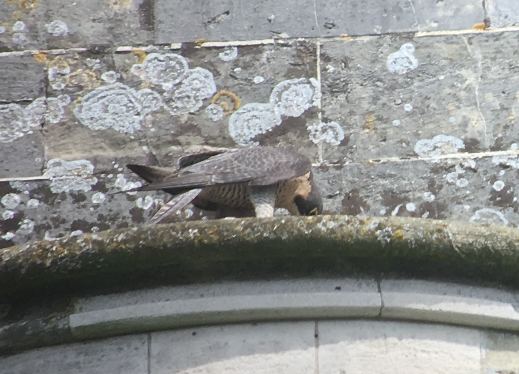
For more news and
photos go to . . . http://www.chichesterperegrines.co.uk/
FRIDAY
MAY 13 - 2016
Slipper
Millpond
I found the
Mute Swan family with five cygnets still
together and looking in fine fettle in the north west
corner of Slipper Millpond near to the Chequers Quay
housing estate.
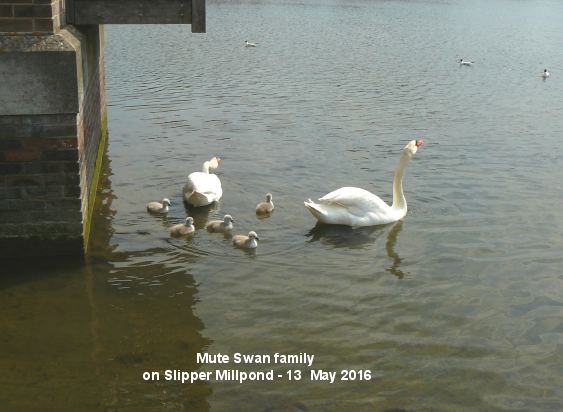
Brendan Gibb-Gray came
out of his house while I was there. He said he had
been dropping small items of bread from his balcony
overlooking the pond, but the cygnets were not taking
it only the adults. I explained that the cygnets
needed more high protein nutritious insect food which
the adults provided by stirring up the mud at the
bottom of the pond.
The Great Black-backed Gull was still sitting
on the nest on the centre raft. Hatching is predicted
for May 16th.
Peter
Pond
I found a good
flowering of Prickly Sow-thistle on the east
side of the pond - with rounded auricles where the
leaves meet the stem. I also found Smooth
Sow-thistle a little further up Lumley Road - here
the auricles simply clasp the stem.
There is also a good growth of Tall Fescue
grass the spikelets of which tend to hang to one
side.
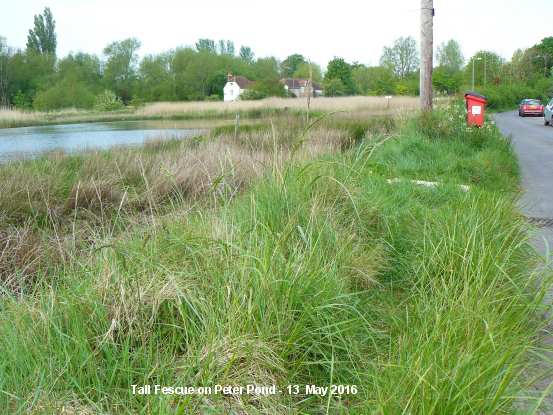
Grey Sedge is
also flowering along Lumley Road near the Lumley
Stream.
I waited again on the Lumley bridge for about 10
minutes with my eyes rained on the pool to the north
where Water Voles have been sighted, but I saw
nothing. I did hear the monotonous churring song of a
Reed Warbler from the reedbeds on the pond.
Brook
Meadow
While I was on
the meadow I happened to meet a couple of birdwatchers
from Hayling Island who reported having seen a pair of
Bullfinches near the north bridge. A very good
sighting. I was pleased to show them some of the
grasses and sedges of the Brook Meadow reserve.
I met Brian Lawrence on the main river path and we
watched a Moorhen and two chicks move down
river among the vegetation. Here is a not very good
shot of the two chicks. The first of the year on the
meadow.
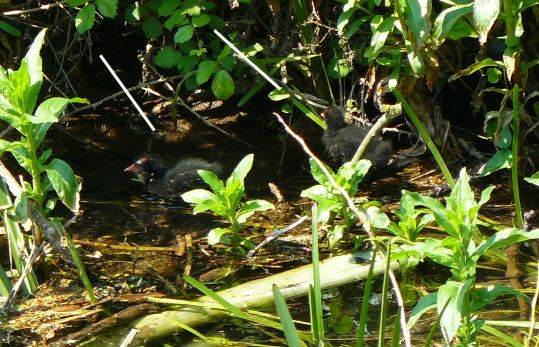
Later Brian got the
best sighting of the day in the form of our first
Beautiful Demoiselle of the year on Brook
Meadow - a male with a metallic blue body and broad
brown wings. The very similar Banded Demoiselle
differs in having a broad band across its wings. Well
done, Brian!
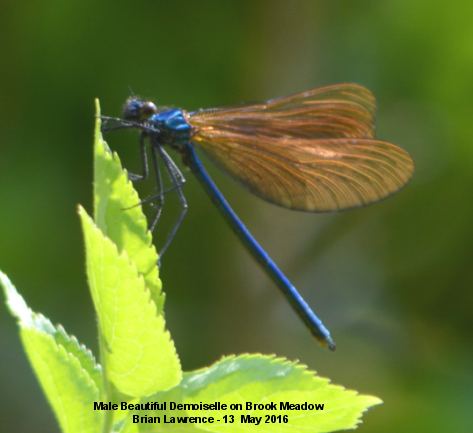
Yesterday's
news
Whilst having
lunch in the garden yesterday, Patrick Murphy saw a
Red Kite fly over, almost directly overhead.
There was no doubt on identification with the
distinctive forked tail. It was flying up Christopher
Way and then veered off towards Westbourne. It might
have been the same bird that I saw flying over
Emsworth on April 16.
Ros Norton reports that among the many birds seen or
heard by the Ems Valley U3A Bird Watching group was a
Short-eared Owl on the ground in a field
between the Deeps and a Cuckoo was
heard.
THURSDAY
MAY 12 - 2016
Hollybank
Woods
Jean and I had
a gentle stroll into Hollybank Woods mainly to see the
Bluebells along the north eastern path adjacent
to Emsworth Common Road. There were plenty of
Bluebells still in flower, but generally they were
past their best. So, if you have not seen them yet,
get up there fast.
We were well compensated by a splendid display of
Wood Speedwell flowers along the main paths,
plus a surprisingly good number of Common Dog-violets
still in flower.
We also saw
Bugle in flower along the Eastern Bridleway
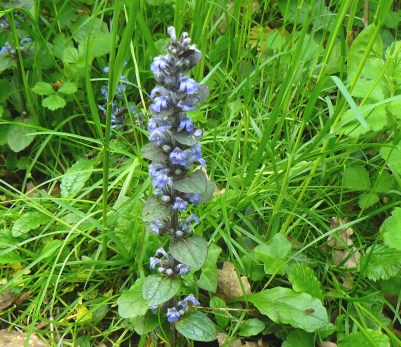
My personal highlight
were the occasional tufts of Wood Millet, which
is a lovely woodland grass with delicate whorled
spreading panicles, rather like the branches of a
tree. This grass is very hard to photograph with a
simple point and shoot camera like mine, so you really
need go into the woods and see the real thing to
appreciate its nature.
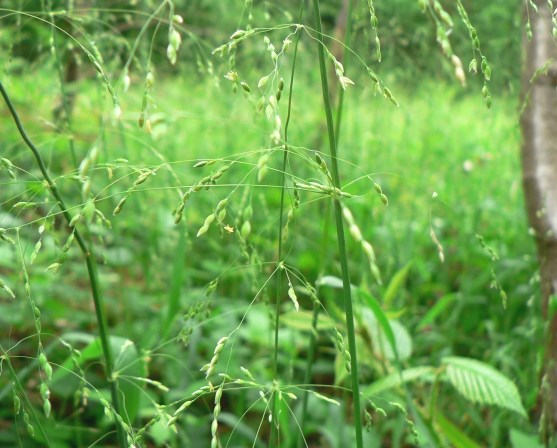
Baffins
cygnets
Eric Eddles
enjoyed a wonderful sight to-day of six cygnets safely
on the centre island at Baffins Pond. Swans are
certainly very productive this year with a record 9
cygnets at Langstone Mill Pond and 5 here on Slipper
Millpond and now 6 at Baffins Pond. Are there any
other good broods locally?
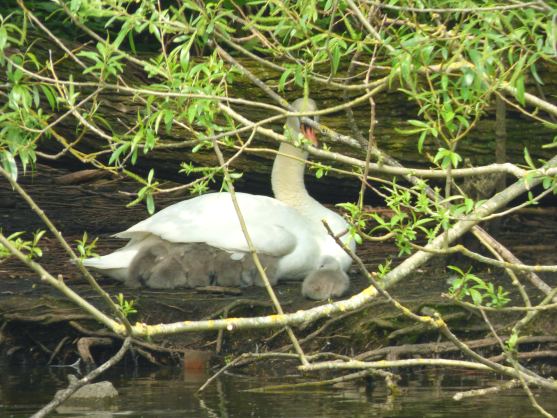
WEDNESDAY
MAY 11 - 2016
Waysides
News
The first
Common Sorrel of the year is now out on the
Bridge Road Wayside by the car park - and no doubt in
many other place too. This is always the first of the
dock family to appear in the spring and is easily
identified from its arrow-shaped leaves with the lobes
pointing backwards.

Sheep's Sorrel is
similar, but is smaller and more delicate than Common
Sorrel and is found in different habitats. The track
down the west side of Thorney Island by Little Deeps
is usually a good place, but I have not checked this
year.
Mute
Swan family - first outing
I went down to
Slipper Millpond at about 11am and found the 5 tiny
swan cygnets from the nest in the reedbeds having
their first outing on the water with mum and dad. Like
all young waterfowl, cygnets accept as parents the
first large moving objects they see and follow them in
preference to anything else. This process is called
imprinting and was discovered by the famous ethologist
Conrad Lorenz. You might well have seen films of Dr
Lorenz being followed by a line of geese that had
become imprinted on him.
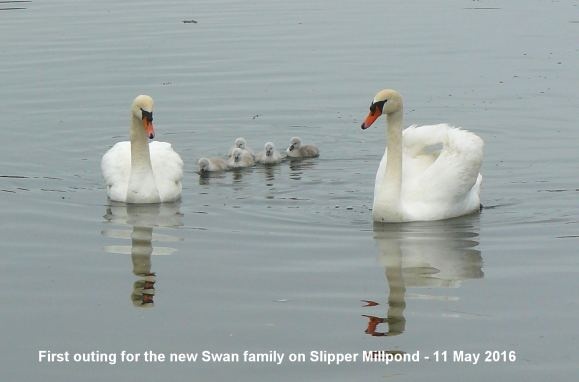
This morning the
parent swans were demonstrating the rudiments of
feeding to the youngsters, for cygnets must learn to
feed themselves from the word go! They also need high
protein animal matter, especially water insects, and
one can often see the adult swans paddling the mud at
the bottom of the pond to dislodge insects and other
food matter for the cygnets
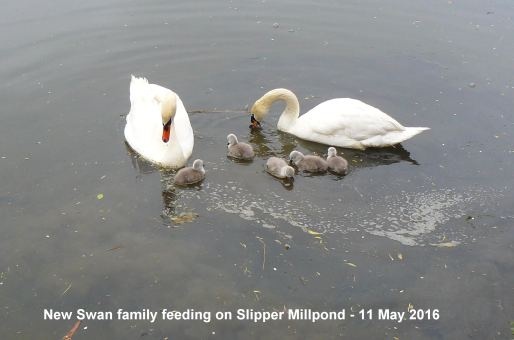
The family may return
to the nest at night, though often the parents will
brood the youngsters by carrying them on their backs
between folded wings. While I was there this morning,
the family did return to the nest, but the cygnets
were not able to climb the steep sides of the nest,
which has been built high the withstand the spring
tides. Sharon Corbett rang me later to say the cygnets
had been able to get onto the nest at high water.
There are just two eggs remaining in the nest, but
they are unlikely to hatch even though the pen's
instinct is to carry on brooding them.
Lumley
Path
I stood on the
small bridge to the north of Peter Pond for about 15
minutes late this morning, hoping for a Water Vole,
but again saw nothing. However, I have alerted the
conservation group to the fact that a Water Vole was
seen on successive days at this spot, so hopefully
there will be many eyes watching out for them. Birds
heard singing included Robin, Wren, Woodpigeon,
Blackcap and Chiffchaff.
Brook
Meadow
I had a look
around the wet Lumley area and it really was wet today
after the early morning rain, so I needed my boots. I
was hoping for Ragged Robin flowers which in the last
two years were out on 13 May and 8 May respectively. I
did not see any sign of them, but I did find my first
False Fox Sedge of the year. This is also a bit
later than normal; I have sometimes found the flowers
out in late April.
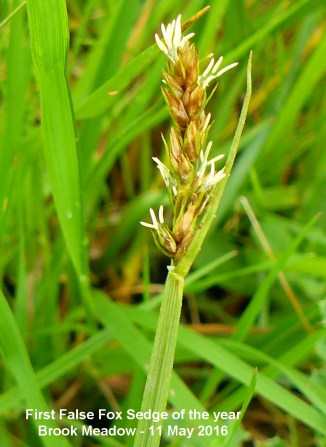
The green sterile
stems of Field Horsetail are now prominent
around the meadow. This is the second phase of growth
of this fascinating plant (if rather unpopular,
particularly with gardeners). The first phase, which
occurs in early spring, produces fertile cone-bearing
stems. Here are both for comparison. The cone on the
left was taken in the spring. The stem on the right
was taken today.
Thomas Iron and his
mum Glynis walked round Brook Meadow this afternoon
and were thrilled to see a good number of Ladybirds.
Young Thomas identified some as Harlequin
Ladybirds with a variety of colours and marking.
More interesting was the first Nursery-web
spider (Pisaura mirabilis) to be
seen on Brook Meadow this year in typical pose resting
on a nettle leaf with its two front legs stuck out.
Well done, Thomas.
Hedgehogs
Our local
Hedgehog expert, Caroline French, was pleased to hear
about the Hedgehog that Jane Allen had in her Kings
Road garden yesterday. Caroline said ... "I have one
coming for food each night but I'm not sure it's
actually living in the garden or using any of my
boxes. Its appearances are less predictable than some
previous hedgehogs. I suspect it's a male which comes
to have some food then goes off to bother a female
somewhere."
Chris Oakley tells me that he put out his night camera
hoping to catch a Hedgehog, but had no success. All he
got was a passing dog fox and a local cat, but he will
keep trying, because Hedgehogs were frequent visitors
to his garden up until a couple of years ago.
Personally, I have not seen one in my Bridge Road
garden since we had a little family in June 2010. Here
are photos of one of the parents and a youngster from
that occasion.
If anyone has any
Hedgehog visiting their garden we would love to hear
about it.
Langstone
Mill Pond
Peter
Milinets-Raby popped down to Langstone Mill Pond and
afterwards walked across the road and quickly checked
Southmoor and the Langbrook Stream estuary this
afternoon 12:57pm to 2:45pm tide coming in). His
observations:
Langstone Mill Pond: I counted 74 Little Egrets, 2
male Gadwall with one female, Blackcap heard, Green
Woodpecker heard, Chiffchaff heard and 3 Reed Warblers
heard. Male and female Reed Bunting (see photo). 6
Swifts and 2 Swallows milling about
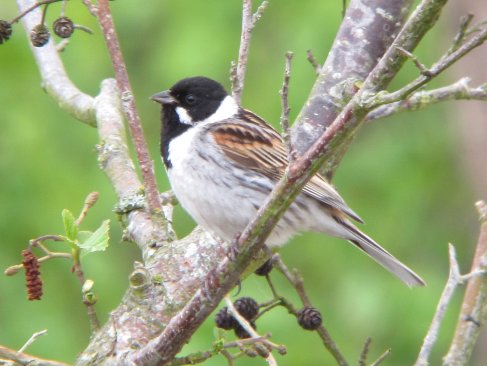
Off shore: 4 Great
Crested Grebes, 3 Common Tern, 5 Med Gulls,
Dropping out of the heavy cloud were a flock of 23
Whimbrel that headed east along the channel. Two birds
dropped to the mud to feed, the rest moved on.
Distantly off Conigar Point: 2 Shelduck, 5 winter
plumaged Bar-tailed Godwit.
Langbrook Stream Estuary/outflow: 3 Common Sandpipers,
2 Adult Mute Swans with 9 cygnets (safe and well). 30+
Common Tern. 13 Med Gulls (3 first summers). 1
Shelduck, 5 Great Crested Grebes.
Southmoor: 2 Linnets, Skylark, 2 Meadow Pipit in song
display flight, 3 House Martin and 7+ Swallow.
TUESDAY
MAY 10 - 2016
Slipper
Millpond
I cycled down
to Slipper Millpond at about 11am this morning to
check on the Mute Swan cygnets which had
started hatching yesterday, as reported to me by
Sharon Corbett. Before I set out I received a phone
call from Gavin Miller to say he had seen some cygnets
in the nest in the reedbeds this morning.
When I arrived at Slipper Road I could see at least 5
cygnets in the nest, three fairly well exposed the
other two being under their mother's wings. Since I
initially counted 8 eggs in the nest there may well be
more than 5 cygnets, though it is not unusual for one
or two of a clutch this size not to hatch.
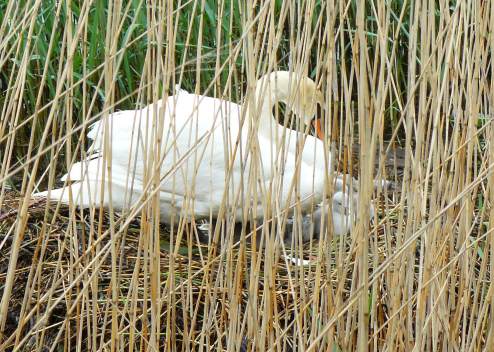
While I was there I
met a couple (Simon and Clare) who were buying the
house next to where the swans were nesting. They were
naturally delighted to see the swan family so close to
their prospective home and to hear about the rest of
the wildlife on and around the millpond. Roger Mills
also turned up and we both welcomed the newcomers to
Emsworth - a very good choice, we both agreed!
A Great Black-backed Gull was sitting on the nest on
the centre raft - hatching should be in about a week's
time.
The Coots nesting on the south raft now have at
least two chicks - their bright red faces can just
be seen looking out from the nest box in this photo.
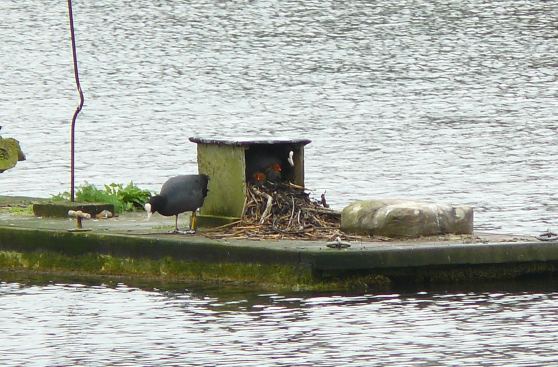
I could not see any
chicks on the other two rafts. However, I did spot a
Coot sitting on a nest on the edge of the island on
Peter Pond; it is easily seen from Lumley Road.
Lumley
Pool
From Slipper
Millpond I headed for the Lumley Stream to have a look
for Water Voles following the sightings reported in
last night's blog. On the way I stopped at the broad
grass verge at the junction of Lumley Road and the
main A259 to admire the Musk Storksbill which
was looking very good.
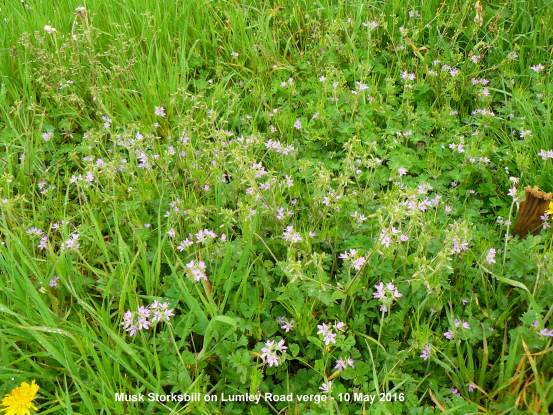
I waited on the Lumley
Path footbridge with camera at the ready for about 15
minutes around 12 noon, but saw nothing. However, I
did enjoy the bird song all around to pool and the
bright yellow flowers of Yellow Flag which have
multiplied considerably since I was last here as few
days ago.
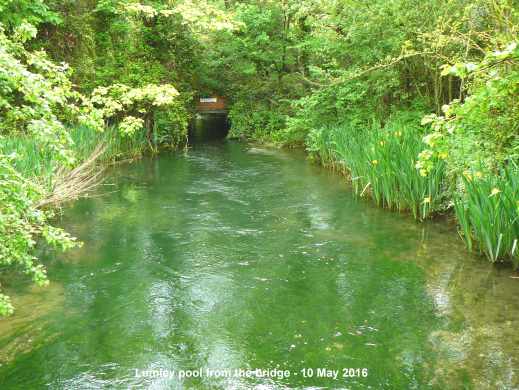
I also noticed that
Germander Speedwell was in flower on the Lumley
Path, a regular place for this delightful plant.
Germander Speedwell is easily identified from the two
lines of hairs on opposite sides of the stem. The very
similar Wood Speedwell has hairs all around the stem.
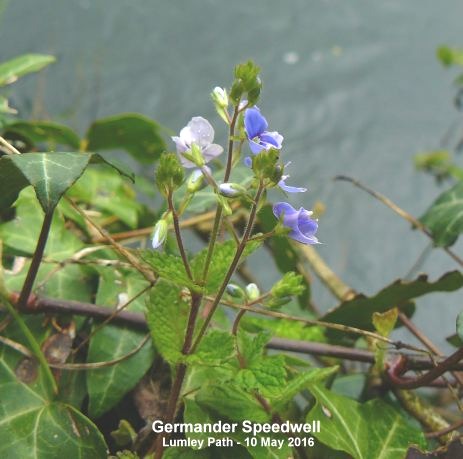
Brook
Meadow
From the
Lumley Path, I went onto Brook Meadow through the
Lumley gate and was immediately confronted by the huge
Horse Chestnut tree completely laden with
pink-flecked white 'candles'. What a wonderful
spectacle! The tree is actually in the garden of
Gooseberry Cottage, though most of its branches hang
over the Brook Meadow site.
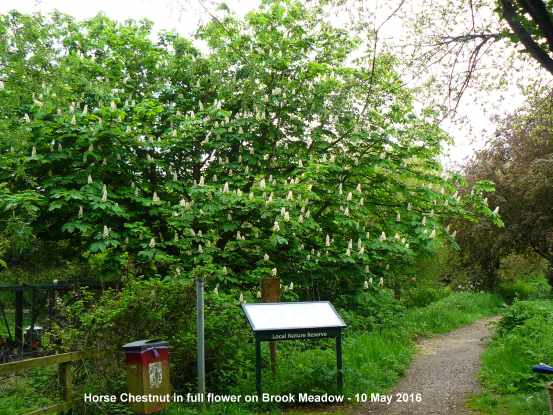

Two Harlequin
Ladybirds were mating on a nettle leaf, both very
different in appearance. Harlequins certainly vary a
great deal in colour and spots. On the right is
another Harlequin I found nearby with hardly any marks
on its wing case. The Harlequins tend to have large
white 'cheeks'.
In contrast here is a
native 7-spot Ladybird I found nearby.
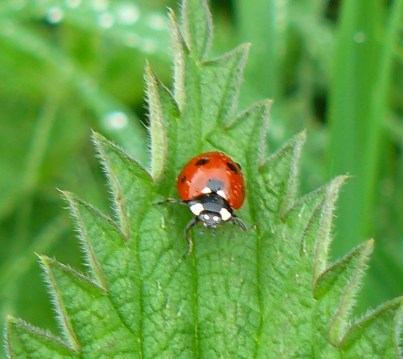
I found my first
Hemlock Water-dropwort in flower on the south
meadow. I hope the conservation group don't see it
otherwise they will chop the flowers in an attempt to
restrict the spread of the plant. Personally, I don't
think removing the flowers makes much difference as
the plants spread vegetatively underground. The best
way to get rid of them is to dig them up like the
conservation did successfully on the botanically
sensitive Lumley area where it was threatening to
engulf the sedges.
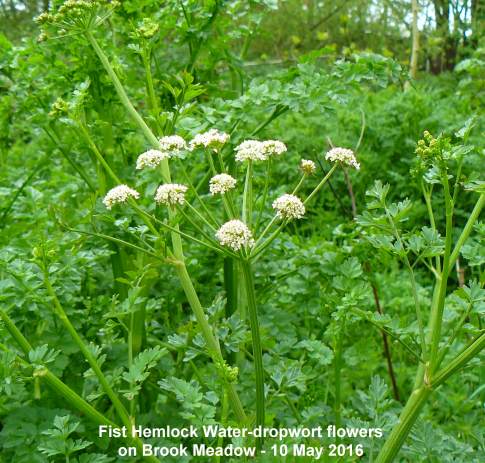
I also noticed
purple-flowered Common Comfrey in the south meadow and
Elder blossom now out above the south bridge.
Hedgehog
returns
Jane Allen was
delighted to report that after 4 years of no show she
finally had a Hedgehog in her garden tonight - at
Kings Road! Jane says they always used to have a few
Hedgehogs that visited regularly, but after finding
one that had been hurt way back they have not seen
anything. So pleased! Caroline French will also be
pleased to hear about another local Hedgehog. How many
others are living in gardens I wonder?
MONDAY
MAY 9 - 2016
Waysides
News
I was to have
met up with Jane Brook for a waysides survey this
morning, but unfortunately we missed each other, so we
each went round on our own! Here is my report.
I started at the Washington Road wayside where
I saw my first Hemlock Water-dropwort starting
to flower, but no sign of any movement on the
Greater Burdock which is the prize plant of
this wayside
I walked on to the
Emsworth Recreation Ground where I found the
usual collection of interesting grasses on the nice
area behind the bowling club. They included lots of
Sweet Vernal-grass, Meadow Foxtail, Field
Wood-rush and Tall Fescue. The Blackthorn scrub
continues to spread and is now seriously threatening
the grassland.
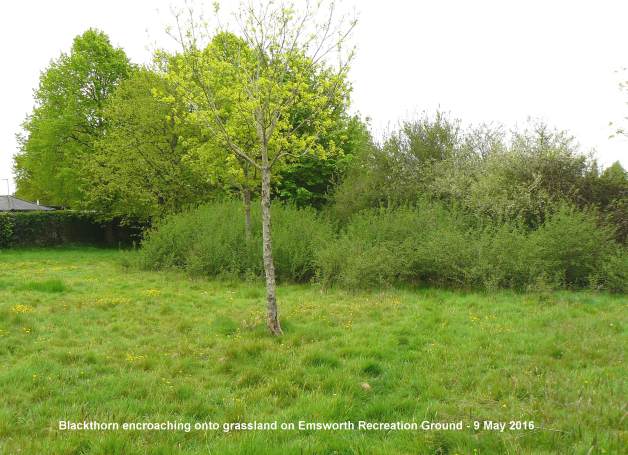
On the track in the
far north-east corner of the Recreation Ground leading
to the gate, as in previous years I found several
tufts of buttercups with turned back sepals which are
likely to be Hairy Buttercups. I have found
these here in previous years and have occasionally dug
one up to establish they are not Bulbous Buttercups.
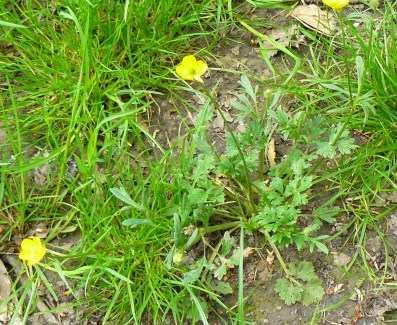
I moved on towards
Christopher Way where I found a magnificent
display of Shining Cranesbill in full flower
along the edge of the path leading from Christopher
Way to Bellevue Lane - certainly the highlight of my
morning. I expected to see some flowers on this shady
path, but this is certainly the best I have ever seen
them with hundreds of tiny bright pink flowers
contrasting with the glossy green leaves. My photo
does not do full justice to the flowers, which must be
seen in situ. Truly wonderful.
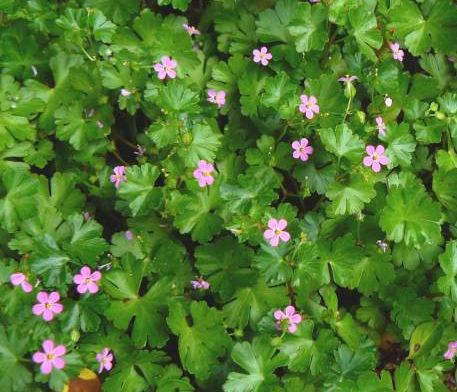
There was nothing of
special interest on the grass verge wayside on
Christopher Way as the cutters had been there
recently. There was no sign of the Wild Clary on the
official wayside, though I could see some battered
leaves on the council verge. I found my first Smooth
Meadow-grass of the year with short
ligules.
I walked back to the
wayside on the junction of New Brighton Road and
Horndean Road where I had my first Hedge Mustard
of the year, but my best find was Wall
Speedwell.
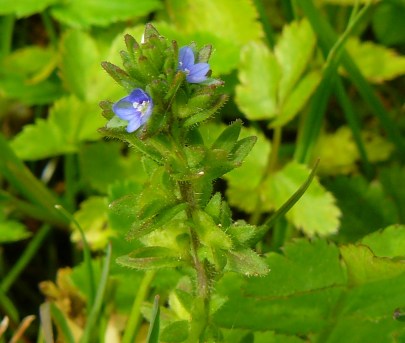
Finally I had a quick
look at the Railway Wayside where I found the
Coltsfoot had largely gone over to seed heads
and the large leaves were growing.
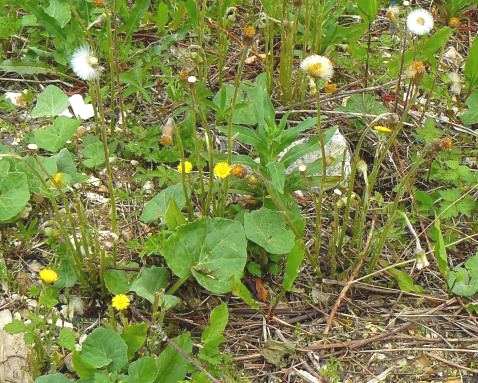
Walking to the top of
the ramp I spotted a few flowers of Keel-fruited
Cornsalad in among some large dock leaves - a
first for this wayside.
Water
Bent
On my way to
Washington Road wayside, I noticed several tufts of
grasses growing between the houses and the pavement on
Victoria Road near its junction with Washington Road.
They were immediately recognisable as Water Bent
(Polypogon viridis) which I have
found on the pavements around the area in previous
years. Interestingly, this grass is not covered in
Francis Rose's book on grasses, but is present in Cope
and Gray's book.
Water Bent is a native
of Southern Europe and the Mediterranean, but has been
widely naturalised elsewhere. Here in Britain it is
confined mainly to Southern England below a line from
the Bristol Channel to the Thames. It occurs in a wide
range of waste and built up habitats, including
pavement cracks, as here. Martin Rand says it is now
widespread in Hampshire and even common around some of
the main built-up areas. It's spreading in much of the
rest of the country too.
Water
Voles are back!
I had two
reports today of a Water Vole seen swimming in the
Lumley Stream where it enters Peter Pond.
Carole Checksfield and her partner saw a Water Vole
swimming in the small pond just north of the Lumley
Path yesterday 8th May at 4.30. She said they had a
really good view of it swimming and resting on the
bank.
Then today, at approximately 11.35am whilst standing
on the small Lumley footbridge with his back to Peter
Pond, Chris Akass saw a Water Vole crossing the Lumley
pond from west to east bank. Chris added "I couldn't
get my phone out quick enough to take a photo. All I
saw was its head and back. It's fur was a very light
brown and it didn't appear to have a long
tail."
How exciting! These
are the first Water Vole sightings we have had on the
Brook Meadow site for over a year. Although they could
well be of the same vole, it does give us hope that
the voles are back at least on the Lumley Stream, if
not on the River Ems as yet. If they are on the Lumley
Stream then it is only a short distance across the
meadow to the River Ems. So, please everyone who reads
this and walks Brook Meadow and the Lumley area keep
looking in the stream and river for any more voles.
Here is a photo of one swimming in the river taken a
couple of years ago, just to remind you what to look
for. Note the blunt nose and tiny ears; Brown Rat has
a sharper nose and longer ears.
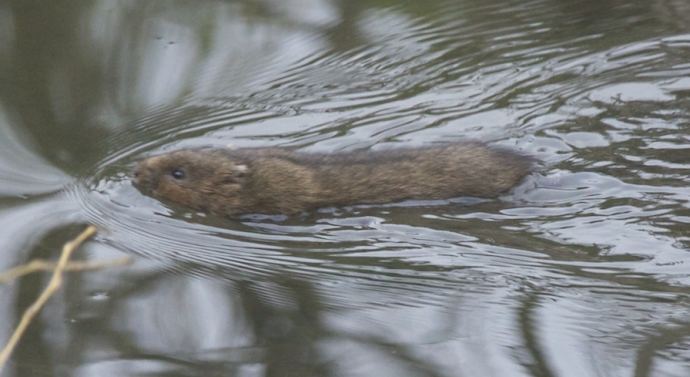
See the special web
page for the history of Water Voles on Brook Meadow
with photos and counts . . .
http://www.brook-meadow.hampshire.org.uk/bm-water-voles.html
Cygnets
born!
I had a phone
call from a very excited Sharon Corbett who lives in
Slipper Road over looking Slipper Millpond to say she
was looking at three swan cygnets which she thinks had
just hatched in the nest in the reedbeds. With up to 8
eggs initially in the nest, we should expect many more
to emerge!
Langstone
Mill Pond
Peter
Milinets-Raby popped down to Langstone Mill Pond this
afternoon (1:52am to 2:55am - very high tide). His
report follows
"Funny, but I have rarely visited on extreme high
tides, so it was a pleasant surprise today to find the
pathway flooded by the combination of high tide and a
brisk easterly wind (see photo).

On the pond were a
pair of Gadwall (he found a mate), a pair of Tufted
Duck (all at peace, now the swans are away!! - I must
check on them)
Also 2 Reed Warblers seen and 2 heard singing, a Reed
Bunting was heard singing, And seeing out the high
tide was a Whimbrel feeding on the last puddle of
water in the horse paddock.
The Grey Heron heronry was very quiet, with the old
south nest with an adult bird re-sitting and on the
other Holm oak nest, the birds were busy displaying
and bringing sticks and almost certainly are going to
re-sit.
The Little Egret colony was back in full swing today
(no idea, why certain nests had been abandoned the
other week). Egrets were everywhere, calling
constantly with lots of display. I counted 35 egrets
sitting on nests with a further 2 pairs engaged in
display beside old nests, so an impressive 37 pairs
(and there maybe the odd nest hidden away that I could
not see as the foliage has grown up quite
significantly).
Off shore on the choppy waters was a single Great
Crested Grebe and overhead were 2 Med
Gulls.
SUNDAY
MAY 8 - 2016
Mute
Swan nest
At about 11am
(2 hours before a high spring tide) I cycled down to
Slipper Millpond to check on the Mute Swan nest. All
seemed to be well, with the pen snug on the nest and
the cob on the water nearby. There was no sign of any
cygnets.
However, at about 1.30pm I had a phone call from Gavin
Miller who said the swan's nest had been swamped by
the 5 metre spring tide and he watched both swans
desperately trying to retrieve the situation. I nipped
down in the car to have a look for myself at 2pm
(about 1 hour after high water) by which time the
situation had settled down and the pen swan was back
on the nest in the reedbeds rebuilding the nest around
her while her mate was swanning around on the water
nearby. I could not see any sign of cygnets, so the
waiting goes on, but hatching must be fairly imminent.
I trust the eggs were not damaged in the swamping.
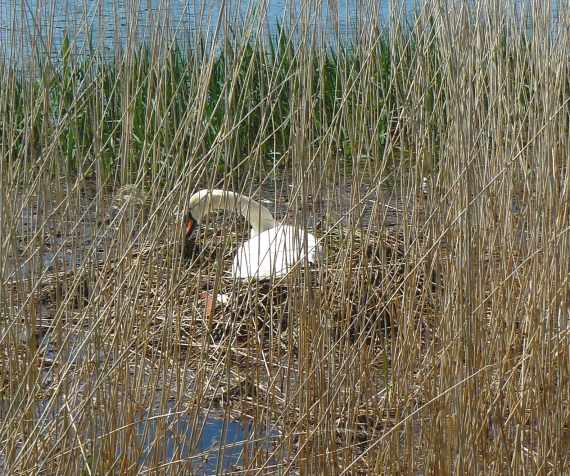
Brook
Meadow
I also had a
look at the Celery-leaved
Buttercups
that Maurice
Lillie discovered yesterday in the south eastern
corner of the south meadow where the ground had been
disturbed by the recent flood defence work on the bund
around Gooseberry Cottage. There was a really good
crop of them, at least 12 plants and mostly in flower
growing on the bare muddy ground near the new pebble
mesh defence at Grid Ref: SU 751 058.

In the same area as
the buttercups there is a good crop of what I thought
at first was Wintercress until I touched the stems
which were decidedly bristly, suggesting
Charlock. The leaves were strongly toothed, but
not bristly as I would have expected. So, the jury is
still out on this one: Wintercress or Charlock? My
money is on the latter!
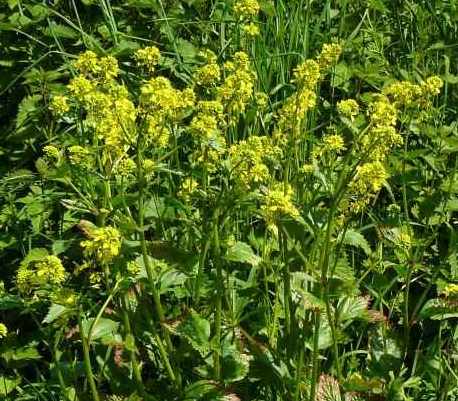
Also in flower in this
general area were Creeping Buttercups, Garlic Mustard,
Cuckooflower and Divided Sedge.
House
Martin survey
Caroline
French reported on her third survey visit to the House
Martin nests she is monitoring at Westbourne.
"I'm pleased to say
there are now plenty of House Martins busily repairing
old nests and building new ones. Watching their aerial
twists and turns and listening to their dry 'prrrt'
calls certainly brought a smile to my face today -
although that wasn't difficult on such a glorious May
morning! I counted 16 at one time but I'm sure there
are many more that that throughout the whole estate.
Of the 12 original nests plus a brand new one being
built on the four properties I am monitoring, adults
are now active at eight.
I noted that the House Martins appear to like to stay
together to some extent. While I was watching, most of
the birds would disappear for a while and then return
a bit later, more or less together. I think some are
perhaps males bringing food to females, while others
are still going off to collect mud for nest-building.
I'll watch to see whether this pattern continues
throughout the season, but I imagine that once they
have young they will be continuously relaying food to
the chicks.
There were two Swifts hunting overhead, and five or
six Swallows around. Plenty of Starlings and House
Sparrow were around too, and I could hear the noisy
begging calls of juvenile Starlings from several
eves.
I'm very impressed with the amount of greenery around
Westbourne - thick hedges, shrubs, climbers, trees
etc. This must all be helping greatly with the amount
of invertebrate food around, along with the many
horses in the area. I hope Westbourne doesn't go the
way of so many other places and start putting block
paving and fencing everywhere. At the moment plenty of
wildlife seems able to thrive there, so well done
Westbourne!
I'm attaching a couple of photos. One shows the
feathered feet of a House Martin and also the very
early beginnings of nest building - just a few blobs
of mud. The other picture shows a House Martin inside
a nest - you can see the pinky 'new' mud on the nest
and on the bill of the bird - repairs to last year's
nest."
A
new wildlife link
John Norton
has taken over from Rod Stern as bryophyte recorder
for VC11 and has set up a 'Hampshire Bryophytes' web
site at . . http://www.jnecology.com/bryophytes
John also has started a blog though he does not know
how long he will be able to keep it up . .
http://blog.jnecology.com
SATURDAY
MAY 7 - 2016
Brook
Meadow
Maurice Lillie
had some interesting plant sightings on the meadow
yesterday. They included our first Celery-leaved
Buttercup of the year in the south eastern corner
of the south meadow. Celery-leaved Buttercup is less
showy than the other buttercups with somewhat washed
out yellow petals and an abnormally large green ovary
in the centre. The leaves are only vaguely
celery-like. Interestingly, this plant has not been
recorded in this location since 2010.

Maurice also spotted a
Lords and Ladies (aka Cuckoo Pint) plant on the
Lumley Path with an open spathe revealing its the deep
brown spadix which contain the flowers. They turn into
bright red berries in late summer.
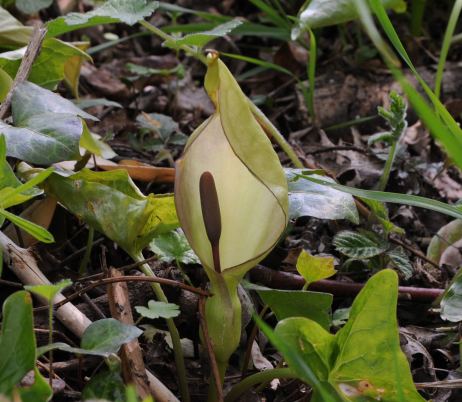
Maurice also snapped
the first Yellow Iris flower of the year in the
Lumley pool, the first of many to brighten this shady
pond.
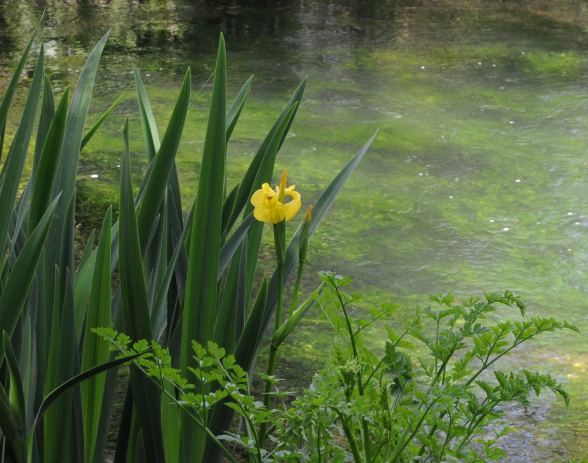
FRIDAY
MAY 6 - 2016
Brook
Meadow
I went looking
for the moss Drepanocladus aduncus
(Kneiff's Hook-moss) that John Norton found on
the Lumley area on May 1, but which I missed when I
last looked for it on May 4. John's suggestion to look
for a 'dark golden moss' was the key and I literally
found it everywhere. It stands out quite clearly from
the more common Brachythecium rutabulum
(Rough Feather-moss). Here is a photo of the
Drepanocladus aduncus I took today (on
the left) alongside John's more close-up photo (on the
right) for comparison. Note the small cup-like fungi
which I have yet to identify.
Looking at the moss
through a microscope (x20)
reveals the falcate (curled) nature of its leaves more
clearly.
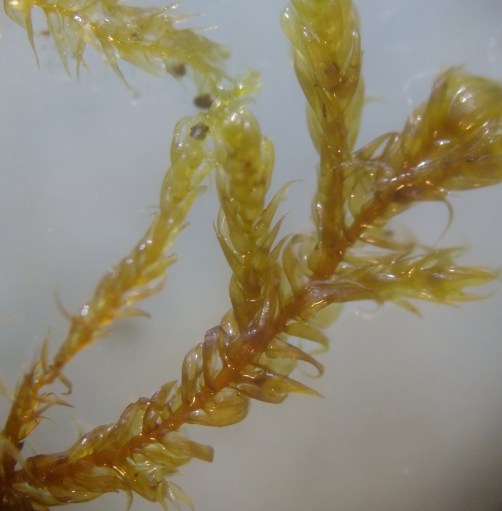
Other observations: I
found the first spikes of Rough Meadow-grass
just starting to emerge along the main river path. As
well as being rough this grass has long pointed
ligules to distinguish it from Smooth Meadow-grass.
Cow Parsley is
now coming into full flower and should produce a fine
display along the main path in a couple of weeks time.
The Bulrushes
are now starting to shed seeds on the west side of the
river. The tiny flowers are grouped into separate
cylindrical spikes with male on top and female below.
Only the female spikes remain in the photo below. The
female spike is the familiar brown fat brown 'cigar'
that releases masses of seeds that are carried on the
wind by their cottony down.
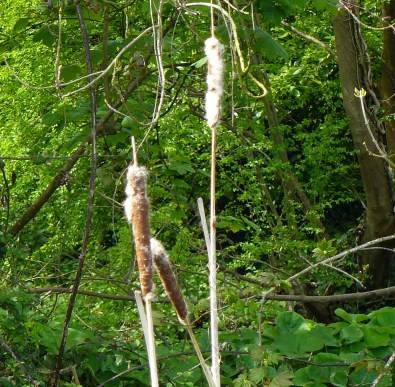
Peter
Pond
A Reed
Warbler was singing strongly from the reedbeds to
the north of Peter Pond when I passed by this morning.
The first of the year.
Common Vetch is in flower on the path to
Gooseberry Cottage from the main road.
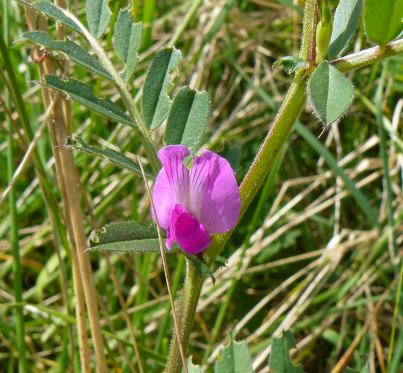
Slipper
Millpond
I was keen to
check the Mute Swan nest in the reedbeds as this was
the hatching day I had predicted. However, there was
no sign of any cygnets. In fact, both swans were very
busy building up their nest in the face of a 4.8m high
tide. The tide will be even higher tomorrow at 5.0m.
There was no change on the centre raft where the Great
Black-backed Gull was still on the nest with its mate
on the water nearby.
A local resident told me that a couple of weeks ago
she had witnessed the cob swan drowning what from her
description appeared to be a Lesser Black-backed Gull
in the pond. I know nothing more about this and I have
not seen any corpse. But I would be interested to hear
from anyone else who saw this event.
Spreading
Yellow Sorrel
Meanwhile,
back home, the first flowers have appeared on the
Spreading Yellow Sorrel in the brickwork of our front
garden. My wife always pulls up this plant which she
says is an invasive weed - too true. But how could one
fail to love such an attractive flower growing in such
difficult circumstances?
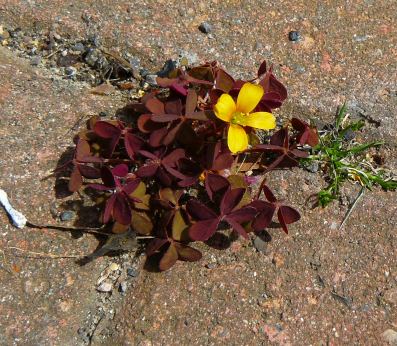
Other
news
Jill Stanley
was down at Gunner Point on Hayling this morning to
photograph the Green-winged orchids and there
were hundreds of them. Well worth a visit. They are
mostly in the area between the pill box (Grid Ref: SZ
691 990) and just past the first seat (Grid Ref: SZ
693 988). Jill's photo shows the green stripes on the
sepals which form the hood, and from where they get
their name.
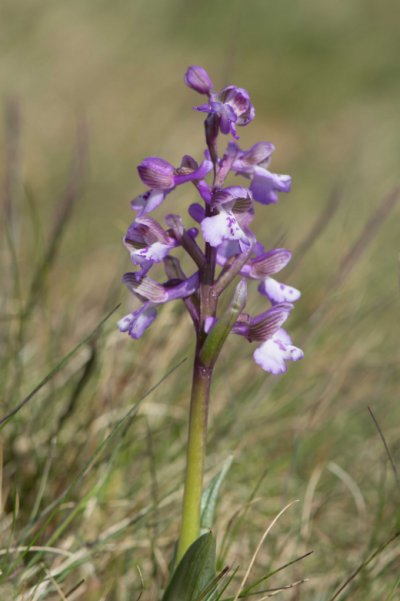
Chris Oakley was also
on Hayling foreshore this morning. Chris noted a pair
of Common Terns performing their high speed
aerobatics. Also a group of six Carrion Crows which he
says belies the saying; 'If there's more than two
Crows, they're Rooks and if there's only one Rook,
it's a crow'.
Barrie Jay was over on the Lee seafront today and saw
many Small Tortoiseshells and got this cracking
photo of one.
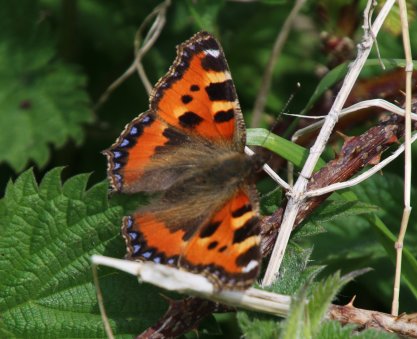
THURSDAY
MAY 5 - 2016
First
Swifts
We had our
first Swifts of the year, three of them, flying over
our garden in Bridge Road at 10am this morning. A
wonderful sign of summer on such a lovely morning.
This is a couple of days earlier than last year, but
about the norm for first arrivals in Bridge Road. My
earliest ever date was May 1 in 2007. This year
Caroline French had the first local Swift sighting at
Westbourne on Apr 28 and Thomas Irons saw one in
Emsworth on May 1.
Ralph Hollins summarised earlier south coast
sightings: The first Swift was at Portland on Mar 31
followed by 2 at Hill Head on Apr 7 and one at
Christchurch on Apr 13. They were seen daily from Apr
15 with the first small flock of 18 near Romsey on Apr
20, then 30+ over Chichester Ivy Lake on Apr 21. Sandy
Point on Hayling had 2 on Apr 21 and 3 singles in off
on Apr 23.
Holly
Blue
Another first
of the year was a Holly Blue in the garden this
afternoon. It fluttered around the Ivy hedge, but did
not stop long enough for a photo. Here is one I got
last year showing its typical black spotted
underwings.
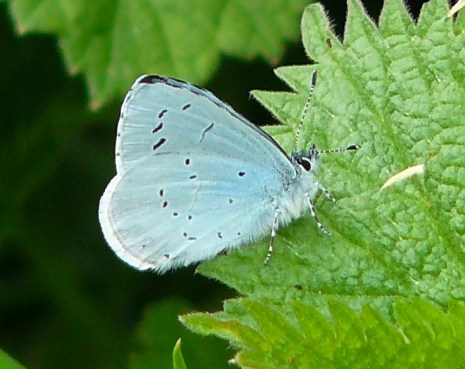
Brian Lawrence also
had a Holly Blue on Brook Meadow yesterday, so they
are definitely out and about. The only other blue
butterfly one is likely to see on Brook Meadow is a
Common Blue, but they won't be out until early June.
In flight the best way to distinguish the two blues is
to remember that Common Blue usually flies low over
grassland, whereas Holly Blue flies high in bushes.
Brook
Meadow mosses
John Norton
provided further information about the
Drepanocladus aduncus moss he discovered
on Brook Meadow on May 1st.
He says, "The
Drepanocladus is quite a common species; mainly
coastal, though I've seen it inland once in a wet
meadow. I couldn't see enough detail in your posted
photo, but there is some dark golden moss by the left
hand cup fungus which looks possible for
Drepanocladus. The plants at Brook Meadow had more
strongly falcate leaves than usual for this
species."
This is the dark
golden moss that John is referring to in my photo
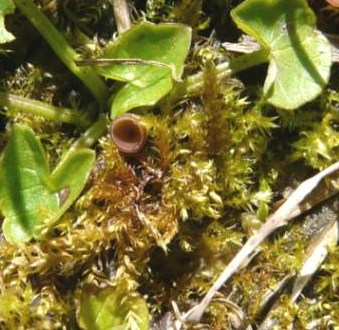
I will have another
look for this dark golden moss that I missed last
time. PS: Falcate means curved, as a sickle.
Warblington
verge cut!
I had an
e-mail last night from Di Ashe alerting me to the fact
that yesterday the council mowing team had cut the
northern grass verge on the Havant Road east of the
Warblington roundabout, which is home to around 50 Bee
Orchids. It was Di who first drew my attention to the
Bee Orchids on this verge last summer (8 June 2015),
but they had gone by the time I went to have a look!
News of this cutting is very disappointing,
particularly since Jayne Lake (of HBC now Norse) and I
had gone to the trouble to survey the verge earlier in
the year (on 23 March 2016), in order to establish the
exact location of the orchids, so that the mowing team
could be warned not to cut there. Grid Ref: SU 730059.
Clearly, the appropriate message had not go through to
the cutting team. However, I am also annoyed with
myself for failing to put up 'Not to be cut' notices
as Jayne and I had agreed at the survey.
I had a look at the verge for myself this afternoon
and was pleasantly surprised to find that most of the
broad verge from the ornamental boat as far west as
the black and white road sign was uncut apart from a
metre strip along the edge of the road. However, the
far end of the verge, nearest the roundabout, had been
completely mown and, sadly, that is where the Bee
Orchids are located!
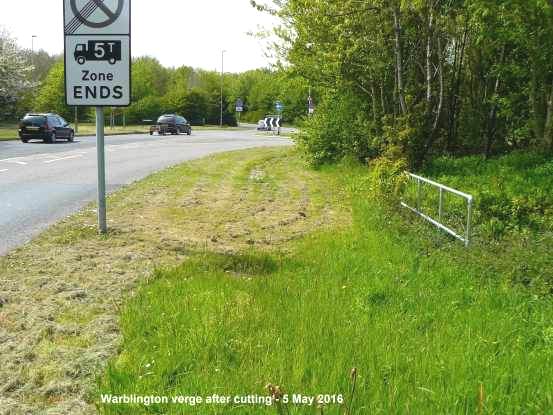
I managed to find some
of the orchids in amongst the grass cuttings; their
leaves were badly cut and mangled and the central
flowering stems also cut. I will make enquiries as to
whether there is still chance that they will flower
this summer.
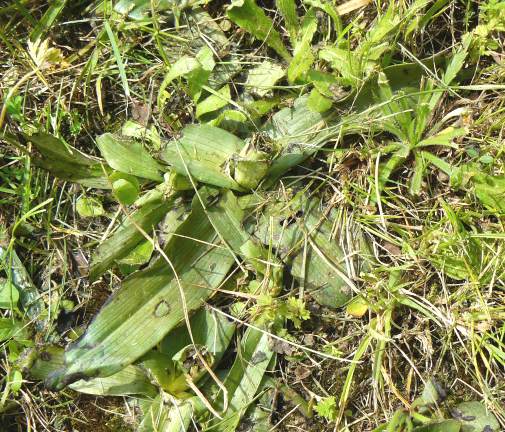
On a more positive
note, the uncut area of the verge is brimming over
with grasses and there are several areas rich in wild
flowers, such as the one shown in this photo.
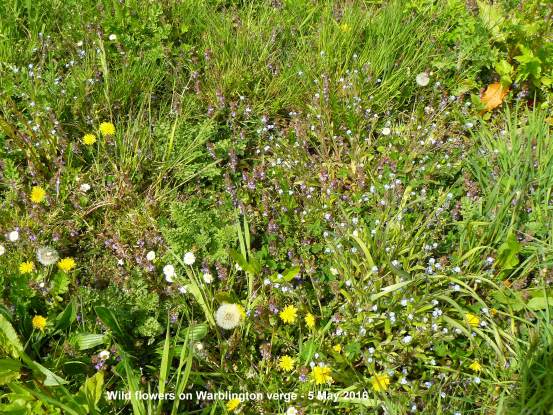
I also found a couple
of very nice patches of flowering Field Madder. So,
there remains plenty of botanical interest on this
verge, if you can get there, that is. It is not easy.
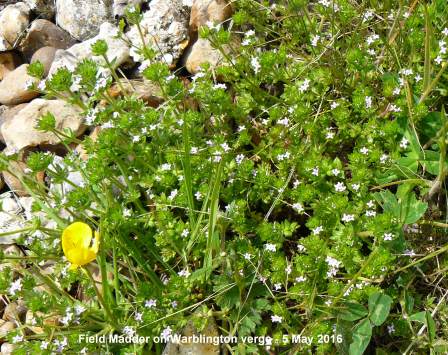
Young
Blackbirds
Patrick Murphy
reports the first young Blackbirds in a nest on top of
some boxes near the roof of his open ended garage. He
says, "We have been unable to look into the nest but
recently I have seen 2 beaks sticking out. Yesterday I
thought I could see a young bird and took a photo. I
was surprised how well it came out showing 2 healthy
young blackbirds. I'm not surprised as the parents
have been constantly flying in with worms."
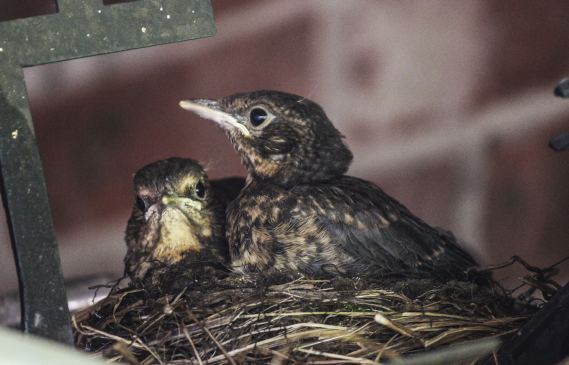
WEDNESDAY
MAY 4 - 2016
Brook
Meadow mosses
John Norton
e-mailed me this morning about the mosses that he and
Peter Milinets-Raby found on Brook Meadow last Sunday
(May 1). He said the photo that Peter Milinets-Raby
provided for yesterday's blog was the wrong one. It
was not of the Drepanocladus aduncus
(Kneiff's Hook-moss), but was most probably a
discoloured Brachythecium rutabulum
(Rough-stalked Feather-moss) which is usually
green, or possibly Leptodictyum riparium
(Kneiff's Feather-moss). We already have both the
latter mosses on our Brook Meadow list from the early
surveys by Rod Stern.
Here
is Peter's photo
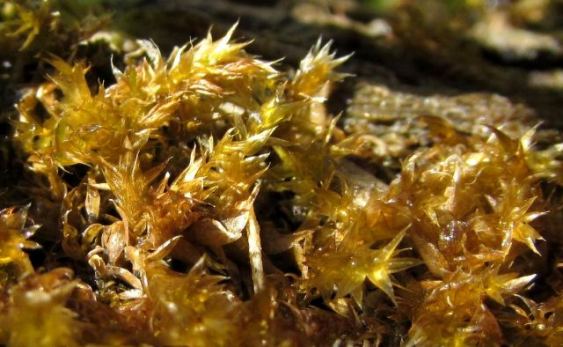
John attached the
correct photo of Drepanocladus aduncus
(Kneiff's Hook-moss) showing the curved leaves
- shown below. He said it is abundant in the small
patch of saltmarsh where the Divided Sedge is
flowering at the moment, ie what we call the Lumley
area and is the most salt-tolerant species in the UK,
so is not unexpected in this place.
Here
is John's photo
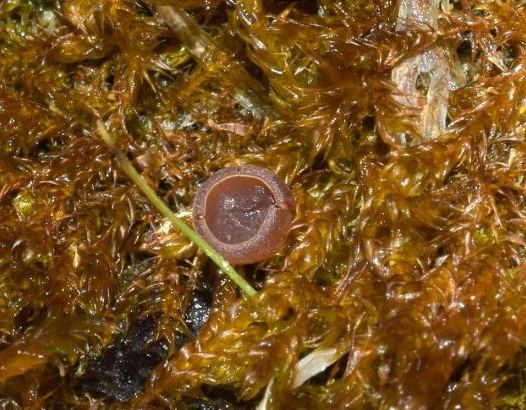
Interestingly, John's
photo also has a small cup-like fungus which he
thought looked interesting! He defined it as a
ascomyscete fungus, but said no more.
These are commonly known as sac fungi. It is very
tiny.
I went over to Brook
Meadow this morning mainly to have a look for the
Kneiff's Hook-moss on the Lumley area. I found some
green moss which I think is the same type as that in
Peter's photo (at the top), probably Kneiff's
Feather-moss. This moss was on the far east of the
Lumley area where the casual path goes down to the
Lumley Stream. Interestingly, it also had some of tiny
sac fungi growing among it that were on John's photo.
I shall need to look again for the Kneiff's
Hook-moss.
Here
is my photo
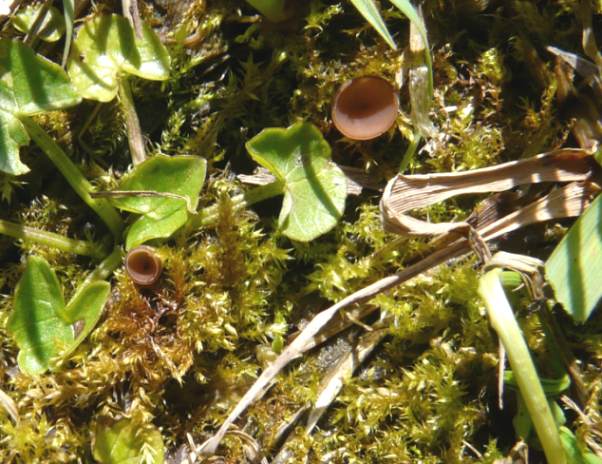
Langstone
Mill Pond
Peter
Milinets-Raby had another quick 30 minute visit to
Langstone Mill Pond today (mid afternoon 2:30pm to
3pm), mainly to check on the Little Egrets
nesting.
"I need an early morning visit to really confirm
things (as the egrets are usually busier in the
morning) but after today's and yesterdays visits I am
concerned that quite a few nests have been abandoned.
The number could be as high as 10 nests having been
deserted, which is very concerning indeed. Could the
constant chilly wind just put them all off??
On the island there appears to be only three nests
occupied (I had a count of 7 nests on the island a
week ago, with two pairs being very active and
obvious!!! Nothing now!).
In the main area, by the Holm Oak I noticed today that
at least 4 nests appeared to be empty and others
looked suspect. The colony was VERY quiet today
(especially as 12 Grey Heron were resting on the salt
marsh). I hopefully will have a definitive answer on
the weekend, but it does look a bit ominous.
The highlights of today were as follows: No Mute Swans
for a second day (obviously on the Langbrook Stream).A
pair of Tufted Duck. 2+ Reed Warbler singing. 3
Swallows over. Chiffchaff singing. off shore (very low
tide) 1 Greenshank, 2 Shelduck, 1 Whimbrel, 2 Med
Gulls, 4 Great Crested Grebes. "
Other
news
Caroline
French saw several Brown Hares and a Mistle Thrush
near Singleton yesterday.
Brian Lawrence saw some Swallows at Langstone.

Barrie Jay had a baby Robin in his garden today -
first of the year?
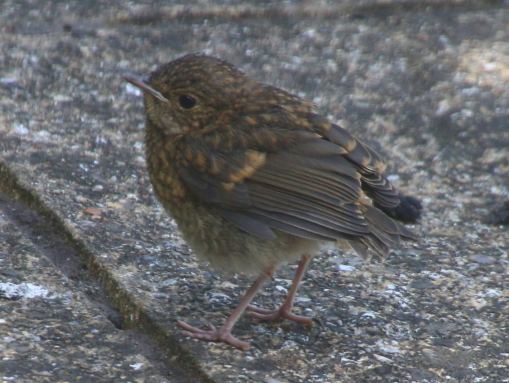
TUESDAY
MAY 3 - 2016
Brook
Meadow
I had a stroll
through Brook Meadow this morning with a cacaphony of
bird song everywhere. Blackcaps were
particularly vocal and I counted at least 4 singing
males (much as Peter Milinets-Raby found yesterday).
It looks like a good year for them. I also heard two
Whitethroat and two Chiffchaff.
Slipper
Millpond
No change at
Slipper Millpond where the Mute Swan and the Great
Black-backed Gull were sitting on their respective
nests in the reeds and on the centre raft. I noticed a
large shoal of about 50 Grey Mullett swimming
around in the shallow water near Chequers Quay. Tried
to get a photo, but no good.
Waysides
News
Coming back
through Bridge Road car park I stopped to count the
Cuckooflowers on the wayside grass verge which
numbered 268 - a good count but far off the record of
694 in 2012. I also found a few spikes of False Fox
Sedge - my first of the year.
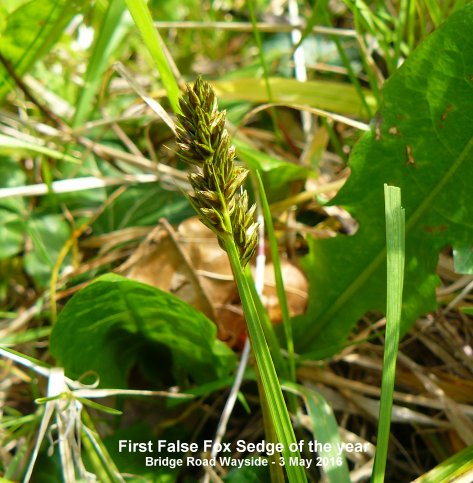
Garden
Slow-worms
While she was
doing a bit of gardening this morning my wife came
across three Slow-worms basking in the warm sunshine,
the most we had ever seen in the garden together. One
of the worms was half in and half out of a crack on
the brickwork of a wall. We had not seen so many
Slow-worm in the garden.
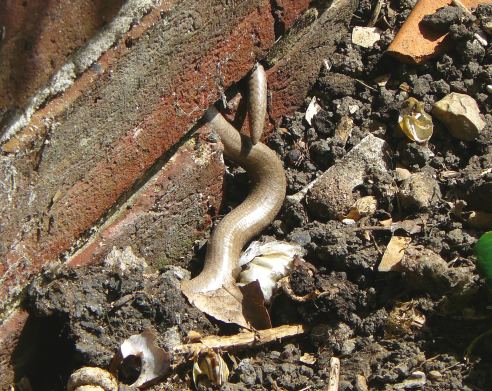
SUNDAY
MAY 1 - MONDAY MAY 2 - 2016
Catch-up on
news while I was away
Brook
Meadow
Peter
Milinets-Raby and his botanist friend John Norton
wandered around Brook Meadow on Sunday 1st May mainly
in search of rare mosses. John's best find was
Kneiff's Hook-moss (Drepanocladus
aduncus) - named after its slightly curved
leaves.
CORRECTION
- This is the wrong photo. It is not of the
Drepanocladus aduncus (Kneiff's
Hook-moss), but is probably a discoloured
Brachythecium rutabulum (Rough-stalked
Feather-moss), which is usually green, or possibly
Leptodictyum riparium (Kneiff's
Feather-moss). We already have both the latter mosses
on our Brook Meadow list from the early surveys by Rod
Stern.
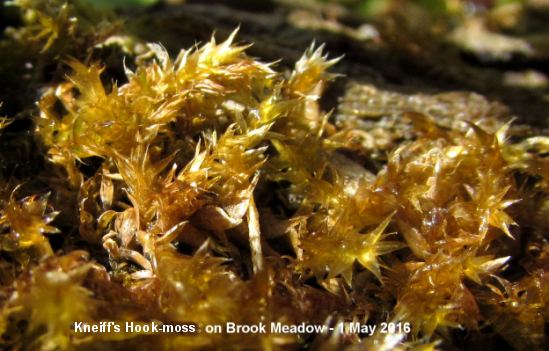
Birds seen by Peter
included 2 female Blackcap, at least 4 male Blackcap,
2 Whitethroat, singing Goldcrest, 2 Chiffchaff.
He also sent photos of Thyme-leaved Speedwell
and Mind-your-own-business (he likes the
name!). The latter can be found on the brick retaining
wall by the tunnel in the north-east corner.
Ringed
Black-headed Gull
Peter
Milinets-Raby saw a Black-headed Gull with a white
ring on its right leg engraved with "2L59" on 2nd
April 2016 feeding in the cattle field south of
Warblington Church. Well, he has just had a reply from
the ringer with the news that his sighting was the
first ever of this bird which was ringed as a chick at
the Cotswold Water Park in Wiltshire on 31st May 2010.
It has eluded detection for 5 years and 307 days -
until Peter spotted it.
First
Thorney Cuckoo
The North
Thorney Cuckoo is back all the way from Africa! Steve
Dennett said it was showing well and calling from a
tree between Thornham Lane and the stilt houses on
Sunday 1 May at 7.45am. Here is Steve's cracking photo
of the bird.
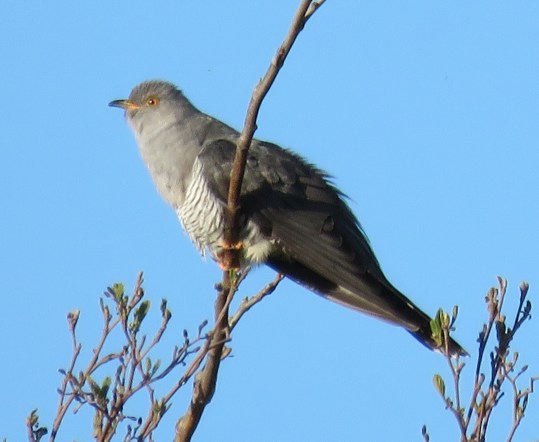
First
Emsworth Swift
I happened to
meet the Irons family on the Emsworth Arts Trail on
Monday May 2. Young Thomas Irons was very excited to
tell me that he had seen what is the first reported
Swift over Emsworth this spring. Well done Thomas!
Caroline French also had one flying over Westbourne on
April 28. So it looks as if they have arrived. But
will they nest locally? We certainly saw very little
of them around Bridge Road last year. So, fingers
crossed. Here is one I got flying over my house in
July 2014.

Langstone
cygnets
Christopher
Evans got this delightful photo of the Mute Swan
family on Langstone Mill Pond with 9 cygnets. Quite a
haul!
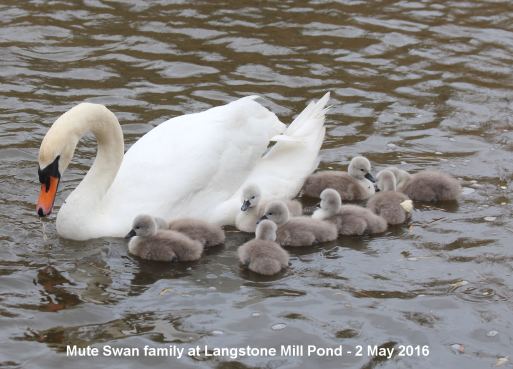
Hayling
Orchids
Despite the
typical Bank Holiday weather, Di Ashe went down to
Gunner Point on West Hayling beach to see the
Green-winged Orchids, which she said were standing
proud in the wind and rain. They should soon be
reaching their peak. I wonder if anyone counts them.

For
earlier observations go to . . April
16-30